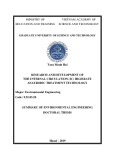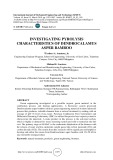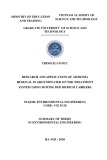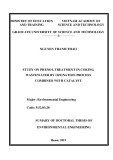
Process water treatment
-
The purpose of this research was to investigate the technological feasibility of biological filtration process for Mn control in Lorne WTP. This thesis consists of eight chapters. Project background and research objectives are described in Chapter 1. Chapter 2 presents an extensive literature review covering the nature of manganese, manganese analytical methods, manganese control methods, the nature of MOB and biological control of Mn in drinking water treatment. The materials and methods used throughout the experimental investigation for this study are described in Chapter 3.
 119p
119p  runthenight04
runthenight04
 02-02-2023
02-02-2023
 6
6
 3
3
 Download
Download
-
The research objectives of the thesi: Manufacturing biochar (BC) and activated carbon from coffee husk; Fabrication of biochar/activated carbon composite materials from coffee husk and MnFe2O4 nanomaterials to treat Cr(VI) and Ni(II) ions in water. Clarifying adsorption mechanism and heavy metal ion adsorption model on VLHP from coffee husk.
 26p
26p  extraenglish
extraenglish
 24-05-2021
24-05-2021
 21
21
 3
3
 Download
Download
-
This thesis focuses on simulating the internal circulation process (gas pulling water) to determine: The amount of water (QN) was pulled up by the amount of gas (QK); and mixing ability of generated gas and circulating water flow, from which to calculate the periodic structure in the IC system.
 27p
27p  capheviahe26
capheviahe26
 25-01-2021
25-01-2021
 21
21
 4
4
 Download
Download
-
Green engineering investigated as a possible organic green material in the combustion process and heating applications. A bioreactor system processed Dendrocalamus asper bamboo culms as green engineering materials to theto industrial process that produces valuable elements from a natural treatment by soaking with an average of pH 7.6 level of sea-water.
 9p
9p  lucastanguyen
lucastanguyen
 01-06-2020
01-06-2020
 15
15
 1
1
 Download
Download
-
Objectives of research: Research on ammonia removal in groundwater in Hanoi with the concentration of less than 25mg/L (20mgN/L) by simultaneous Nitrification and Denitrification process in the equipment using MBBR with porous carriers (DHY) of a high surface area of about 6,000-8,000 m2 /m3 , high porosity and light weight, easily moving in water without addition of substrates.
 26p
26p  xacxuoc4321
xacxuoc4321
 09-07-2019
09-07-2019
 26
26
 6
6
 Download
Download
-
Objectives of thesis: Study on phenol treatment in water by ozonation process combined with catalysts. An empirical kinetic model and one quadratic regression equations were built based on experimental data for destroying phenol by heterogeneous catalytic ozonation process with response variables (initial pH, ozone concentration, catalyst concentration and reaction time). Application of phenol treatment in coking wastewater.
 29p
29p  xacxuoc4321
xacxuoc4321
 08-07-2019
08-07-2019
 19
19
 4
4
 Download
Download
-
Research Reports IWMI’s mission is to improve the management of land and water resources for food, livelihoods and environment. In serving this mission, IWMI concentrates on the integration of policies, technologies and management systems to achieve workable solutions to real problems—practical, relevant results in the field of irrigation and water and land resources.
 39p
39p  nhatro75
nhatro75
 12-07-2012
12-07-2012
 68
68
 8
8
 Download
Download
CHỦ ĐỀ BẠN MUỐN TÌM




















